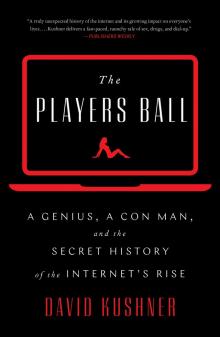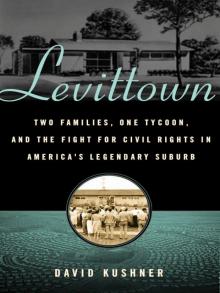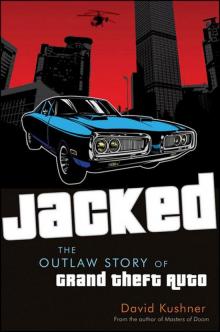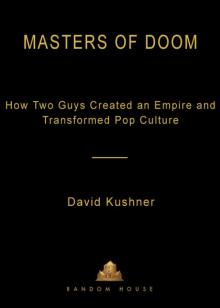- Home
- David Kushner
Masters of Doom Page 2
Masters of Doom Read online
Page 2
His parents were less than impressed by his new passion. At issue were Romero’s grades, which had plummeted from A’s and B’s to C’s and D’s. He was bright but too easily distracted, they thought, too consumed by games and computers. Despite this being the golden age of video games—with arcade games bringing in $5 billion a year and even home systems earning $1 billion—his stepfather did not believe game development to be a proper vocation. “You’ll never make any money making games,” he often said. “You need to make something people really need, like business applications.”
As the fights with his stepfather escalated, so did Romero’s imagination. He began exorcising the backwash of emotional and physical violence through his illustrations. For years he had been raised on comics—the B-movie horror of E.C. Comics, the scatological satire of MAD, the heroic adventures of Spider-Man and the Fantastic Four. By age eleven, he churned out his own. In one, a dog named Chewy was invited to play ball with his owner. With a strong throw, the owner hurled the ball into Chewy’s eye, causing the dog’s head to split open and spill out green brains. “The End,” Romero scrawled at the bottom, adding the epitaph “Poor Ol’ Chewy.”
At school, Romero turned in a homemade comic book called Weird for an art class assignment. In one section he described and illustrated “10 Different Ways to Torture Someone,” including “Poke a needle all over the victim’s body and in a few days . . . watch him turn into a giant scab” and “Burn the victim’s feet while victim is strapped in a chair.” Another, titled “How to Drive the Babysitter Mad!,” illustrated suggestions including “Get out a very sharp dagger and pretend that you stabbed yourself” and “Stick electric cord into your ears and pretend that you are a radio.” The teacher returned the assignment with a note that read, “This was awfully gross. I don’t think it needs to be that way.” Romero got a B+ for his artistic efforts. But he saved his hardest work for his code.
Within weeks of his first trip to Sierra College, he had programmed his first computer game: a text adventure. Because the mainframes couldn’t save data, the programming had to be punched on waxy paper cards; each card represented a line of code—a typical game would take thousands. After every day at the school, Romero would wrap the stack of cards in bungee cord around the back of his bike and pedal home. When he’d return to the lab the next time, he’d have to feed the cards into the computer again to get the game to run. One day on the way home from the college, Romero’s bike hit a bump in the road. Two hundred cards went flying into the air and scattered across the wet ground. Romero decided it was time to move on.
He soon found his next love: the Apple II computer. Apple had become the darling of the indie hacker set ever since the machine was introduced at a 1976 meeting of the Homebrew Computer Club, a ragtag group of California techies. As the first accessible home computers, Apples were ideally suited for making and playing games. This was thanks in no small part to the roots of the company’s cofounders, Steve Jobs and Stephen Wozniak—or, as they became known, the Two Steves.
Jobs, a college dropout with a passion for Buddhism and philosophy, took his first job at a start-up video game company called Atari in the mid-seventies. Atari was legendary because its founder, Nolan Bushnell, had produced the 1972 arcade hit, Pong, a tennislike game that challenged players to maneuver white strip paddles on either side of the screen while hitting a dot back and forth. Jobs would share the confidence and brashness of his boss, who had hacked Spacewar to create his first arcade game, Computer Space. But Jobs had larger plans to realize with his childhood friend Wozniak, a.k.a. Woz, a math whiz who could spend hours playing a video game.
Woz was equal parts programming genius and mischievous prankster, known around the San Francisco Bay Area for running his own dial-a-joke phone number. In computers, Woz found the perfect place to combine his humor and his math skills, creating a game that flashed the message “Oh Shit” on the screen when the player lost a round. Jobs recruited Woz to design Breakout, a new game for Atari. This alchemy of Jobs’s entrepreneurial vision and Woz’s programming ingenuity gave birth to their company, Apple. Created in 1976, the first Apple computer was essentially a prototype for the Homebrew crowd, priced devilishly at $666.66. But the Apple II, made the following year, was mass market, with a keyboard, BASIC compatibility, and, best of all, color graphics. There was no hard drive, but it came with two game paddles. It was made for games.
Romero had first seen the stylish beige Apple II computers up at Sierra College. While a mainframe’s graphics were capable of, at best, spitting out white blocks and lines, the Apple II’s monitor burst with color and high-resolution dots. Romero had spent the rest of the day running around the lab trying to find out all he could about this magical new box. Whenever he was at the school, Romero played the increasingly diverse lineup of Apple II games.
Many were rip-offs of arcade hits like Asteroids and Space Invaders. Others showed signs of true innovation. For instance, Ultima. Richard Garriott, a.k.a. Lord British, the son of an astronaut in Texas, spoke in Middle English and created the massively successful graphical role-playing series of Ultima games. As in Dungeons and Dragons, players chose to be wizards or elves, fighting dragons and building characters. The graphics were crude, with landscapes represented by blocky colored squares; a green block, ostensibly, a tree; a brown one, a mountain. Players never saw their smudgy stick figure characters attacking monsters, they would just walk up to a dragon blip and wait for a text explanation of the results. But gamers overlooked the crudeness for what the games implied: a novelistic and participatory experience, a world.
Ultima also showed off the latent entrepreneurship of this new breed of hackers. Garriott came to fame in the early eighties through his own initiative. Like many other Apple II programmers, he would hand-distribute his games on floppy disks sealed in clear plastic Ziploc bags to local computer stores. Ken and Roberta Williams, a young married couple in Northern California, also pioneered the Ziploc distribution method, turning their homemade graphical role-playing games into a $10 million–a–year company, Sierra On-Line—a haven of hippie digerati with hot tub parties to boot. Silas Warner, a six-foot, nine-inch, 320-pound legend, cofounded his own company, Muse Software, and put out another of Romero’s favorite games, the darkly suspenseful Castle Wolfenstein, in which players ran their stick figure characters through a series of plain mazes while battling Nazis and, ultimately, Hitler himself.
Romero spent so much time on the games that his stepfather decided it was best for the family to have a computer at home, where they could better keep an eye on him. The day the Apple II arrived, he found his wife standing at the door. “Promise you won’t get angry,” she pleaded. An empty Apple II box sat in the living room. “Johnny put it all together already,” she said cautiously. A few ill-sounding beeps could be heard. Enraged, Schuneman stomped down the hall and flung open the door, expecting to encounter a savage pile of plastic and wires. Instead he found Romero at the functioning machine, typing. His stepfather stood for a minute quietly, then went in and let the boy show him some games.
For Christmas that year, 1982, Romero had two requests: a book called Apple Graphics Arcade Tutorial and another called Assembly Lines, which explained assembly language, a faster and more cryptic code. These books became his lifeblood when his stepfather took the family on a job reassignment to the Royal Air Force base in Alconbury, a small town in central England. There Romero wrote games that could exploit his refined assembly language skills. He drew his own packages and created his own artwork. Selling his games at school, Romero became known for his skills.
Romero’s stepfather knew something was up when an officer working on a classified Russian dogfight simulation asked him if his stepson was interested in a part-time job. The next day an officer led the boy into an icy room filled with large computers. A black drape blocked Romero’s view of the classified maps, documents, and machines. He was told they needed help translating a program from a mainframe to a minicompu
ter. On the monitor he saw a crudely drawn flight simulation. “No problem,” he said. “I know everything about games.”
Romero was ready for the big time. The computer was now a cultural icon. Time magazine even put a computer on its cover in place of its usual Man of the Year as 1982’s “Machine of the Year.” Games for the computer were becoming all the more enticing as video games—made for systems or “consoles” that hooked up to television sets—collapsed with a resounding crash. A surplus of games and hardware had led to $536 million in losses for Atari alone in 1983. Meanwhile, home computers were gaining speed. Commodore’s VIC-20 and 64 computers helped it surpass Apple with $1 billion in sales. And these computers needed games.
For a kid working with an Apple II, there were two ways to get published in the nascent industry. The big publishers, like Sierra and Electronic Arts, Romero found, were fairly inaccessible. More within his reach were the enthusiast magazines, which, to save costs, printed games as code on their pages. To play, the reader would have to type the program laboriously into a computer.
While in England, Romero spent every spare moment in front of the Apple, working on games to send away for publication. The resulting slip in his grades angered his stepfather, reviving old battles and inspiring, for Romero, new comics he called “Melvin.” The action was always the same: Melvin, a boy, would do something his father, a bald guy with sunglasses, like his stepdad, had told him not to do—then suffer the creatively grisly consequences. In one strip, Melvin agrees to do the dishes but instead disappears to play computer games. After discovering this, his dad waits until Melvin is sleeping, runs into his room screaming, “You little fucker!” then punches his face into a bloody, eye-popping pulp. Romero wasn’t the only one who found a release in the violent comics. Kids at school would sneak him ideas for how Melvin should meet his doom. Romero drew them all, exaggerating every opportunity for scatological gore. He was much admired.
The attention changed him. He was listening to heavy metal—Judas Priest, Metallica, Mötley Crüe. He dated a half dozen girls. The one he liked best soon became his girlfriend, a popular, intelligent, and outgoing daughter of a respected officer. She had him buy button-down shirts, wear nice jeans and contacts. After years of being beaten down by his father and his stepfather, Romero was finally getting recognition.
At sixteen, Romero was just as eager to have success with his games. After eight months of rejections, the good news came on March 5, 1984, from an Apple magazine called InCider. An editor, weary from a recent trip to Mardi Gras, wrote that the magazine had decided to publish the code for Romero’s Scout Search, a low-resolution maze game in which the player—represented by a single dot—had to gather all his scouts—more dots—before being attacked by a grizzly bear—another dot. It didn’t look great, but it was fun to play. Romero would be paid $100. And the magazine might be interested in publishing some of the other games Romero had sent in. “I’ll get around to them as soon as my hangover clears up,” the editor wrote.
Romero put all his energy into making more games, for which he did all the programming and art. He could program one game in a half hour. He arrived at a naming convention: every game title was a two-word alliteration, like Alien Attack or Cavern Crusader. He grew increasingly brash. “When I win this month’s [programming] contest,” he wrote to one magazine, “(I will win; my program’s awesome!), instead of a $500 prize, could I just take the $500? The same goes for the annual prize of $1000 (which I’ll get also).” He signed this letter, like all of them, “John Romero, Ace Programmer.” And he won the cash.
The success inspired him to get back in touch with his biological dad, who was living in Utah. In a letter he wrote on makeshift letterhead for his company, Capitol Ideas Software, he was eager to show how far he’d come, telling about all the contests and publications. “I’ve been learning computers for 41/2 years now,” Romero wrote. “My programming has just undergone another revolution.” This time he signed his letter “John Romero, Ace Programmer, Contest Winner, Future Rich Person.” He was already on his way, he could feel it. But to make it big, Future Rich Person big, he had to leave England and get back to America.
Romero got his wish in 1986, when he returned with his family to California. He signed up for classes at Sierra College, which he started just before finishing his senior year of high school. His publishing rolled; almost everything he churned out found its way into a computer magazine. His games made magazine covers. And, during a shift at Burger King, he fell in love.
Kelly Mitchell came into the restaurant one day and caught Romero’s eye from behind the cash register. The two began dating. Kelly was the daughter of an upper-middle-class Mormon family. Best of all, she lived in a cool house high on a hill in town. Though Romero had dated other girls, no one was as fun and compatible as Kelly—even if she didn’t care about games. For nineteen-year-old Romero, it seemed like the chance to start the family he’d never really had. He proposed, and the two were married in 1987.
He decided it was time to go for his dream job. He had published ten games. He was about to graduate from high school. He was taking on a family. He needed a gig. The opportunity came on September 15, 1987, with a gathering for Apple computer enthusiasts called the Applefest. Romero had read about it in a computer magazine and knew that everyone would be there: the big game publishers, Origin and Sierra, as well as the magazines that were keeping him gainfully published, Uptime, Nibble, and InCider. He arrived at the convention center in San Francisco as hackers and gamers lugged monitors, printouts, and disks inside. A table overflowed with Nibble magazines that featured one of Romero’s games on the cover. In the booth for Uptime, a computer magazine published on floppy disk, another of his games played on the monitors. Oh yeah, Romero thought, I’m gonna do well here.
At the Uptime booth, Romero met Jay Wilbur, the editor who had been buying up his work. Jay, a strapping twenty-seven-year-old former bartender at T.G.I. Friday’s, looked like a kid pumped up with air and peppered with facial hair. Jay had a soft spot for Romero: an irreverent but reliable programmer who understood the magic formula of a great game—easy to learn, difficult to master. Jay offered him a job. With typical bravado, Romero told him he’d have think about it.
Buzzed on his Uptime meeting, Romero headed right for the Origin booth, where a banner read, “Ultima V: Coming October 31!” Oh my God, Romero thought, the next Ultima! He sat down in front of a machine and popped in his disk. “What do you think you’re doing?” a woman in marketing from Origin asked him. “You’re taking our game out of our machine! You’re not supposed to do that!”
Romero tapped a few keys. “Look at this!” he said. On the screen appeared a maze chase. He had written it using a complicated program that doubled the resolution of the graphics, making it look, essentially, twice as colorful and pristine. So-called double-res graphics were considered the high art of programming, and here was this skinny kid showing off some game that looked even better than the Ultima version on screen. The woman had only one question: “Are you looking for a job?”
Two months later, in November 1987, Romero was driving across the country, heading for his first day of work at Origin’s office in New Hampshire. Eager but broke, he wrote hot checks to pay for tollbooth fees. He was driving with Kelly, his pregnant wife—their first baby was due in February. Kelly was less than thrilled about heading off into the snow, but Romero had convinced her in his charming and enthusiastic way. His life as an Ace Programmer and Rich Person was on its way, he promised.
The promise fell through. Despite his immediate success at Origin, Romero took the gamble of joining his boss, who was leaving to start a new company. It was a bad bet. The start-up couldn’t drum up the requisite business. Before long Romero—now twenty-one years old with a wife, a baby boy, Michael, and another child on the way—was out of a job. The strain was beginning to wear on Kelly. Romero’s hyperbole seemed to have no payoff, and she had returned to California to have her second baby n
ear her parents. Romero had to call and tell her that there was nothing: no job, no apartment. He was sleeping on a friend’s couch.
But Romero wasn’t going to lie down and die. He had a dream to pursue, a family he loved. He could be the dad he’d never had himself, the kind of dad who would not just support his kids’ games but play them. Romero phoned Jay Wilbur to see about a job at Uptime. Jay told him he was leaving Uptime to join his competitor Softdisk in Shreveport, Louisiana. Maybe, Jay suggested, Romero could get a job there too. Romero didn’t hesitate. Sure, he’d go to Shreveport. The weather was there. The games were there. And so, he hoped, were the most hard-core of gamers.
TWO
The Rocket Scientist
John Carmack was a late talker. His parents were concerned until one day in 1971, when the fifteen-month-old boy waddled into the living room holding a sponge and uttered not just a single word but a complete sentence: “Here’s your loofah, Daddy.” It was as if he didn’t want to mince words until he had something sensible to say. “Inga,” the boy’s father, Stan, told his wife, “perhaps we might have something a bit extraordinary on our hands.”
The Carmacks were already a self-taught family. John Carmack’s paternal grandfather and namesake was an electrician with a second-grade education, taught to read and write by his wife, a homemaker who had reached only the eighth grade. They raised their boy Stan in the poorest part of eastern Kentucky; Stan studied hard enough to earn a scholarship to a university, where he excelled at engineering, math, and eventually broadcast journalism and became the family’s first college graduate. His wife was the daughter of a chemist and a physiotherapist. She inherited the interest in science, pursuing both nuclear medicine and a doctorate in microbiology. Inga and Stan, attractive college sweethearts, would pass their love of learning on to their first son.

 The Players Ball
The Players Ball Alligator Candy
Alligator Candy Levittown
Levittown Jacked: The Outlaw Story of Grand Theft Auto
Jacked: The Outlaw Story of Grand Theft Auto Masters of Doom
Masters of Doom